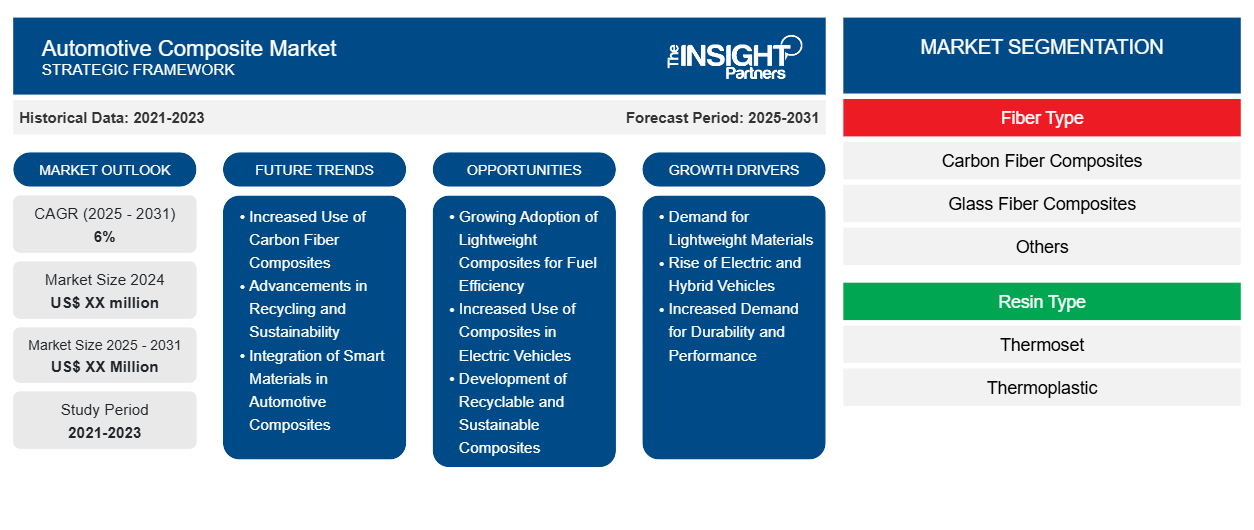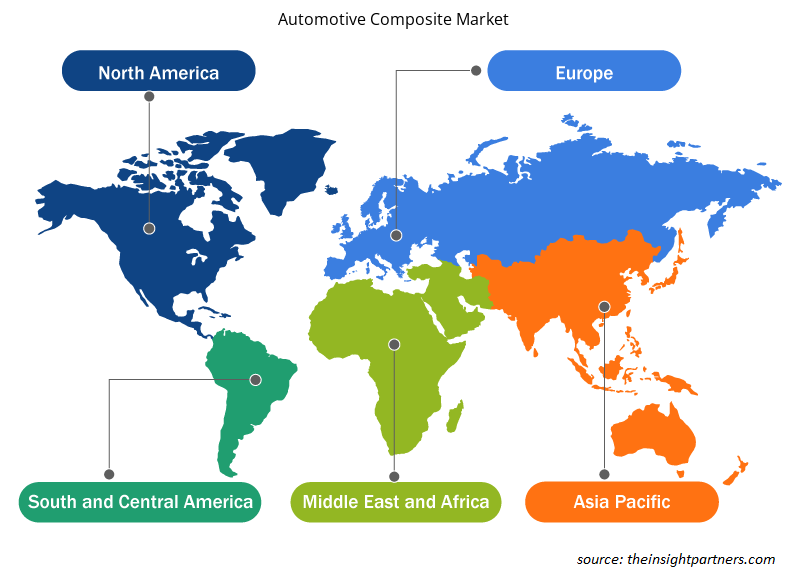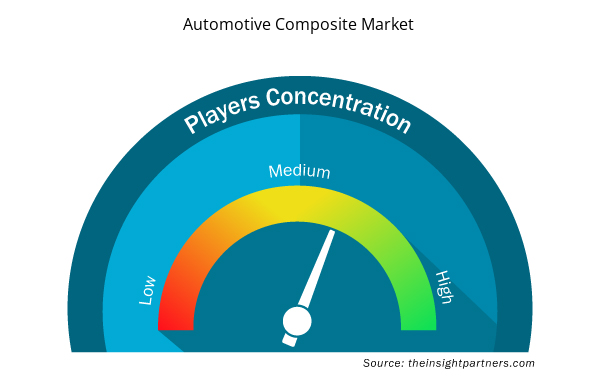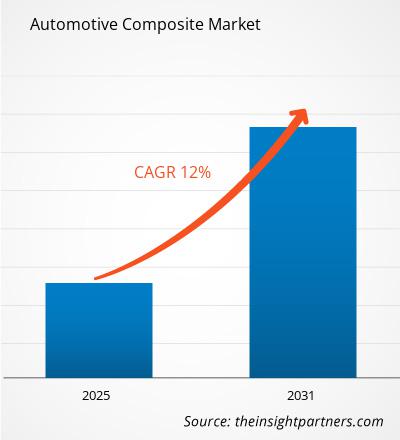The automotive composites market is expected to reach US$ 28.30 billion by 2031 from US$ 13.00 billion in 2024. The market is estimated to register a CAGR of 12.0% during the forecast period.
The report is segmented by Fiber Type (Carbon Fiber Composites, Glass Fiber Composites, and Others). The report further presents analysis based on, Resin Type [Thermoset (Polyester, Vinyl Ester, Epoxy, Polyurethane, and Others), Thermoplastic (Polypropylene, Polyethylene, Polyvinylchloride, Polystyrene, Polyethylene Terephthalate, Polycarbonate, and Others)]. Based on Based on Vehicle Type report is segmented into (Passenger Vehicles, Light Commercial Vehicles (LCV), Heavy Commercial Vehicles and Two Wheelers and Others) The global analysis is further broken-down at regional level and major countries. The Report Offers the Value in USD for the above analysis and segments.
Purpose of the Report
The report Automotive Composite Market by The Insight Partners aims to describe the present landscape and future growth, top driving factors, challenges, and opportunities. This will provide insights to various business stakeholders, such as:
- Technology Providers/Manufacturers: To understand the evolving market dynamics and know the potential growth opportunities, enabling them to make informed strategic decisions.
- Investors: To conduct a comprehensive trend analysis regarding the market growth rate, market financial projections, and opportunities that exist across the value chain.
- Regulatory bodies: To regulate policies and police activities in the market with the aim of minimizing abuse, preserving investor trust and confidence, and upholding the integrity and stability of the market.
Automotive Composite Market Segmentation
Fiber Type
- Carbon Fiber Composites
- Glass Fiber Composites
- Others
Resin Type
- Thermoset
- Thermoplastic
Customize This Report To Suit Your Requirement
You will get customization on any report - free of charge - including parts of this report, or country-level analysis, Excel Data pack, as well as avail great offers and discounts for start-ups & universities
Automotive Composite Market: Strategic Insights

- Get Top Key Market Trends of this report.This FREE sample will include data analysis, ranging from market trends to estimates and forecasts.
Automotive Composite Market Growth Drivers
- Demand for Lightweight Materials: The automotive industry is increasingly focused on reducing vehicle weight to improve fuel efficiency and reduce emissions. Automotive composites, such as carbon fiber-reinforced plastics and glass-fiber composites, offer lightweight solutions without compromising strength and durability. Their use in body panels, chassis, and interiors is accelerating.
- Rise of Electric and Hybrid Vehicles: The growing popularity of electric vehicles (EVs) and hybrid vehicles, which require lightweight materials to maximize battery performance and range, is driving the demand for automotive composites. These materials help improve overall energy efficiency, offering enhanced strength-to-weight ratios.
- Increased Demand for Durability and Performance: Automotive composites are known for their durability, resistance to corrosion, and ability to withstand harsh environmental conditions. As vehicles become more technologically advanced, the need for materials that offer high performance while being lightweight, corrosion-resistant, and cost-effective continues to grow.
Automotive Composite Market Future Trends
- Increased Use of Carbon Fiber Composites: As automakers focus on improving fuel efficiency and reducing vehicle weight, carbon fiber composites are expected to become more widespread. These materials offer significant strength-to-weight ratios, improving vehicle performance and energy efficiency, particularly in electric vehicles, luxury cars, and high-performance sports vehicles.
- Advancements in Recycling and Sustainability: The future of automotive composites will see a focus on improving the recyclability of composite materials. The development of composite materials that are easier to recycle and more sustainable will drive growth in the automotive sector, as environmental concerns and waste reduction become more critical.
- Integration of Smart Materials in Automotive Composites: The rise of smart composites with self-healing properties, sensors, and other integrated functionalities is expected to revolutionize the automotive industry. These materials will enable vehicles to monitor their condition, repair minor damages, and improve overall vehicle performance, leading to increased durability and reduced maintenance costs.
Automotive Composite Market Opportunities
- Growing Adoption of Lightweight Composites for Fuel Efficiency: As automakers focus on improving fuel efficiency, lightweight composites, such as carbon fiber and fiberglass, represent a key market opportunity. These materials are being integrated into vehicle body parts, chassis, and interior components to reduce weight, improve performance, and meet regulatory emissions targets.
- Increased Use of Composites in Electric Vehicles: The shift to electric vehicles (EVs) offers significant opportunities for the automotive composites market. EVs require lightweight materials to maximize battery range and efficiency, and composites are ideal for this purpose. As EV production increases, the demand for advanced composites in areas like battery housings, structural components, and interior elements will rise.
- Development of Recyclable and Sustainable Composites: With increasing emphasis on sustainability, there is a growing market for recyclable and eco-friendly automotive composites. Manufacturers are innovating with bio-based composites and recyclable materials, which can meet both performance and environmental requirements, presenting a lucrative opportunity in the green automotive sector.
Automotive Composite Market Regional Insights
The regional trends and factors influencing the Automotive Composite Market throughout the forecast period have been thoroughly explained by the analysts at Insight Partners. This section also discusses Automotive Composite Market segments and geography across North America, Europe, Asia Pacific, Middle East and Africa, and South and Central America.

- Get the Regional Specific Data for Automotive Composite Market
Automotive Composite Market Report Scope
| Report Attribute | Details |
|---|---|
| Market size in 2024 | US$ 13.00 Billion |
| Market Size by 2031 | US$ 28.30 Billion |
| Global CAGR (2025 - 2031) | 12.0% |
| Historical Data | 2021-2023 |
| Forecast period | 2025-2031 |
| Segments Covered |
By Fiber Type
|
| Regions and Countries Covered | North America
|
| Market leaders and key company profiles |
Automotive Composite Market Players Density: Understanding Its Impact on Business Dynamics
The Automotive Composite Market market is growing rapidly, driven by increasing end-user demand due to factors such as evolving consumer preferences, technological advancements, and greater awareness of the product's benefits. As demand rises, businesses are expanding their offerings, innovating to meet consumer needs, and capitalizing on emerging trends, which further fuels market growth.
Market players density refers to the distribution of firms or companies operating within a particular market or industry. It indicates how many competitors (market players) are present in a given market space relative to its size or total market value.
Major Companies operating in the Automotive Composite Market are:
- Toray Industries Inc.
- SGL Carbon
- TEIJIN LIMITED
- Mitsubishi Chemical Corporation.
- Hexcel Corporation
Disclaimer: The companies listed above are not ranked in any particular order.

- Get the Automotive Composite Market top key players overview
Key Selling Points
- Comprehensive Coverage: The report comprehensively covers the analysis of products, services, types, and end users of the Automotive Composite Market, providing a holistic landscape.
- Expert Analysis: The report is compiled based on the in-depth understanding of industry experts and analysts.
- Up-to-date Information: The report assures business relevance due to its coverage of recent information and data trends.
- Customization Options: This report can be customized to cater to specific client requirements and suit the business strategies aptly.
The research report on the Automotive Composite Market can, therefore, help spearhead the trail of decoding and understanding the industry scenario and growth prospects. Although there can be a few valid concerns, the overall benefits of this report tend to outweigh the disadvantages.
- Historical Analysis (2 Years), Base Year, Forecast (7 Years) with CAGR
- PEST and SWOT Analysis
- Market Size Value / Volume - Global, Regional, Country
- Industry and Competitive Landscape
- Excel Dataset


- Toothpaste Market
- Wheat Protein Market
- Artificial Turf Market
- Virtual Production Market
- Small Molecule Drug Discovery Market
- Single-Use Negative Pressure Wound Therapy Devices Market
- Equipment Rental Software Market
- Cosmetic Bioactive Ingredients Market
- Thermal Energy Storage Market
- Terahertz Technology Market

Report Coverage
Revenue forecast, Company Analysis, Industry landscape, Growth factors, and Trends

Segment Covered
This text is related
to segments covered.

Regional Scope
North America, Europe, Asia Pacific, Middle East & Africa, South & Central America

Country Scope
This text is related
to country scope.
Frequently Asked Questions
DuPont de Nemours Inc, Gurit Holding AG, Hexion Inc, Mitsubishi Chemical Holdings Corp, Nippon Electric Glass Co Ltd, Owens Corning are some of the key players operating in the automotive composites market
Based on geography, Asia Pacific held the largest share of the automotive composites market due to the well-established automotive industry across the region
Increased use of carbon fiber composites is expected to be the key market trends.
Based on fiber type, the carbon fiber segment is expected to witness the fastest growth during the forecast period
The Automotive Composite Market is estimated to witness a CAGR of 12.0% from 2025 to 2031
Demand for lightweight materials is driving the automotive composites market growth.
Trends and growth analysis reports related to Chemicals and Materials : READ MORE..
The List of Companies
- Toray Industries Inc.
- SGL Carbon
- TEIJIN LIMITED
- Mitsubishi Chemical Corporation.
- Hexcel Corporation
- John Manville Corporation
- Owens Corning
- Zoltek Carbon Fiber
- Cytec Solvay Group
- Gurit

 Get Free Sample For
Get Free Sample For